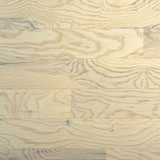What is Hardwood Flooring?

Hardwood Flooring refers to boards of flooring made directly from big pieces of wood, cut right off some trees, rather than things from recycled wood material, like the wood particle material used to make laminate floors, or the grass used to make bamboo flooring. There are floors which look like, but are not made of wood, such as a lot of vinyl plank flooring, but hardwood flooring is the genuine article. It’s considered the premium in flooring, the gold standard.
A real hardwood floor gives a room a high class look, and adds value to a home, helping it sell faster and for more money than those without genuine wood plank floors. It comes in a variety of species, strengths, colors, finishes (such as glossy or not), and board sizes. We’ll cover the very basics on this page. Links on any term or topic will take you to a page with more details. For instance design. There is LOT to be said about flooring and interior design, but to be exceedingly general with hardwood flooring, lighter colors tend to be used in more casual settings, both contemporary and country looks. Darker colors are usually placed in more traditionally designed places, or very formal, elegant rooms.
Hardwood comes in two major types, solid and engineered, and uses a variety of installation methods. When properly cared for a hardwood floor can last for generations – 100 years is not unheard of.
Two Kinds of Hardwood
It comes in two types. Boards of solid hardwood are made out of a single piece of wood. A piece of timber is milled into the board, so the entire board is 100% the species that you have selected. Engineered hardwood is 100% wood, but it is not 100% the species you have chosen. It’s made by either bonding multiple layers of wood together, with the top layer being the species, or by applying the designated species top layer to a core board made of recycled wood, bonded together. Engineered woods tend to be stronger, and less responsive to the environment, so moisture and temperature don’t affect them as much as they do solid wood.
Factors to consider when purchasing a hardwood floor
Where can Hardwood go in my house?
• No wood flooring should be installed in an area prone to excessive wetness or humidity, such as a bathroom with a frequently used shower, or a basement that floods, even slightly. Look for something fully waterproof, or at the least very water and moisture resistant, for these places.
• You’ll have to look at your specific manufacturing instructions, but in general no hardwood floor should put over a floor with a radiant heating system if the temperature will exceeds 80º F.
• In basements, or below grade (below ground level), you should only choose an engineered hardwood product, rather than solid, to control the expansion and contraction issues that would otherwise come with the extra moisture.
Those are the hard restrictions. After that, you will want to consider the traffic level in the room you are considering. If the traffic will be higher, you will want the floor to be harder. A rating system called the Janka Hardness Scale will help you make these determinations. Be aware that if your floor is not properly cared for, even the hardest flooring will show its wear. Also know that there is no wood grown on Earth which can withstand the jagged terror that is the High Heeled Shoe. It is the mortal enemy of all floors wooden, and should never, ever, ever be worn when walking on a hardwood floor. Never.
How do you select the species that is right for you?
Your two biggest concerns with regard to species are durability and look. Consider how hard you need your flooring to be based on the expected kind of traffic the area is going to handle. Consult the Janka Hardness Scale, and find the level of durability you need. Once you have ruled out the woods that are too soft, you can base your decisions on aesthetics. Different species not only have different color tones, but also different grain patterns, and levels of contrast between grain and the wood proper. You can order samples, and look deeper into your short list for specific considerations.

|

|

|

|

|
What is the difference between First Quality, Cabin Grade and Tavern Grade?
With laminate flooring, these kinds of terms refer to production quality issues. With hardwood flooring, it’s also about the amount of character a particular box of flooring will have. Hardwood flooring is not made from wood that has been processed, like the cores in a laminate plank, which can be pressed into perfection. It’s a natural product, taken right off a tree and milled into a board. With first quality wood, all of your boards will be structurally sound and installable. Cabin Grade is the industry term manufacturers use for boards made from the exact same wood as their first quality boards, but which come through with more mineral streaks, variations in the grain pattern, spotting on the finish, knots, even imperfections in a locking system. 95% of our customers who have ordered an additional 15 to 20% more material than their needed square footage have been able to finish their floors with these products. Even with that overage, they still saved 50-75% off the price of first quality hardwood, and their floors looked the same.
While the other 80% of the cabin (also known as 'shop' or 'tavern') grade flooring is not going to be perfect, not every board will have the same blemish, some may have none. Take the time to go through the material and sort out boards, to plan your placement of the best planks, using blemished pieces as the ones you cut off to finish a row, place in a closet, or where the couch will be. Some people hide all of the blemishes and are left with a first quality look while others work them in, letting extra knots and grain add to the rustic reality of the look of their floor. It’s a matter of personal judgment. If it's not for you, great, go with first quality (and still save, with us, at least), but if you are considering a cabin grade purchase, feel free to call us and ask any questions that you have. We sell a lot of it to a lot of happy people, so we'll have answers for you. Taking a little more time to prepare an installation can get you an amazing floor at quite a discount.
How Will It Be Installed?
There are four basic installation methods for hardwoods.
GLUE DOWN is what it sounds like, you use a professional adhesive, but basically you’re gluing the wood to your subfloor. This is usually only done over concrete, and only with engineered or parquet wood. With an engineered floor, this can help you get more of the feel of a solid hardwood vs. having a floating type.
NAIL DOWN is best over a subfloor of at least 3/4″ thick plywood, or if your solid hardwood is going directly over your floor joists. Nail down is common with solid hardwood, which can almost never go directly onto concrete anyway. You generally need to nail down 3/4″ solid hardwood, and can also do it with engineered hardwood that is 5/8″ or more thick, and bamboo floors of 1/2″ or more in thickness.
STAPLE DOWN uses a pneumatic gun to drive the staples, not ... you know, a Swingline, I guess. The staples are 1.5 to 2 inches long. This is the best installation method for most engineered wood floors, and any bamboos under 1/2″ thick. It can also be used for thinner solids, around the 5/16″ range of thicknesses.
FLOATING FLOOR means that the hardwood is not actually attached to the subfloor. If any glue is used, it will be to glue the boards to each other, not to the subfloor, and many installations don’t even do that. This is not (yet) recommended for solid hardwoods. Floating floors allow for better protection against moisture because you can use an unbroken moisture barrier or even some padding.
What else will be needed to complete the floor?
In addition to the wood and any padding, you will need to have trims and moldings. These are the finishing touches to cap off a floor, or to merge it with another floor in a manor more elegant than with mere, bare plank ends.
When could you be living on your floor?
Here are some factors you can use to get a rough estimate.
1. How much time you will take to select and purchase your floor. Some spend months looking into it, and that's reasonable! It's an expensive, unusual purchase the results of which you'll live with for a long time.
Add the time to receive your flooring. Floors To Your Home keeps flooring in stock, so you could have your hardwood at your home about 5 – 7 business days after your order is complete, even if you get your flooring with free shipping.
2. Hardwood needs to acclimate in the room where it will be installed for 5 – 7 days. This same time can be used for other materials, but usually 24-48 hours is the minimum for any product.
3. Installation: 1 – 4 days. That’s sort of a stab in the dark, because you may use an installer, or do it yourself; and you may have unfinished or pre- finished wood, so the time will vary.
4. Returning the furnishings to room: 1 day max.
– – – –
David has written and made videos about flooring products and installation since 2011 at Floors To Your Home (.com), where he is also the PPC Manager, a Researcher, a Website & Marketing Strategy Team member, Videographer, Social Strategist, Photographer and all around Resource Jito. In my spare time I shoot and edit video, put together a podcast, explore film history, and mix music (as in ‘play with Beatles multi-tracks’). Connect with
W. David Lichty
Follow Team Floors To Your Home on Facebook

 Brown Tone
Brown Tone
 Red Tone
Red Tone
 Golden Tone
Golden Tone
 Gray Tone
Gray Tone
 Light Tone
Light Tone
 Medium Tone
Medium Tone
 Dark Tone
Dark Tone
 Multi Color
Multi Color
